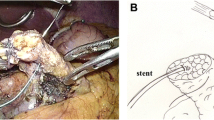Abstract
Background
A number of technical improvements regarding the pancreatic anastomosis have decreased the morbidity and mortality after pancreaticoduodenectomy. However, postoperative pancreatic fistula (POPF) remains is the most feared complication, and the ideal technique for pancreatic reconstruction is undetermined.
Materials and methods
This study is a retrospective review of a prospectively maintained database. Data were collected from all consecutive robot-assisted pancreaticoduodenectomies (RAPD), performed by a single surgeon, at the University of Illinois Hospital & Health Sciences System, between September 2007 and January 2016.
Results
A total of 28 consecutive patients (16 male and 12 female) who underwent a RAPD were included in this study. Patients had a mean age and mean BMI of 61.5 years (SD = 12.3) and 27 kg/m2 (SD = 4.9), respectively. The mean operative time was 468.2 min (SD = 73.7) and the average estimated blood loss was 216.1 ml (SD = 113.1). The mean length of hospitalization was 13.1 days (SD = 5.4). There was no clinically significant POPF registered.
Conclusion
Trans-gastric pancreaticogastrostomy (TPG) represents a valid and feasible option as a pancreatic digestive reconstruction during RAPD. Initial results showed decreased incidence of POPF with an increased risk of postoperative bleeding. Our experience suggests that TPG might be safer than pancreaticojejunostomy (PJ); further studies are needed in order to confirm.









Similar content being viewed by others
References
Fernandes E, Giulianotti PC (2013) Robotic-assisted pancreatic surgery. J Hepatobiliary Pancreat Sci 20(6):583–589
Cirocchi R et al (2013) A systematic review on robotic pancreaticoduodenectomy. Surg Oncol 22(4):238–246
Baker EH et al (2015) Robotic pancreaticoduodenectomy for pancreatic adenocarcinoma: role in 2014 and beyond. J Gastrointest Oncol 6(4):396–405
Guerrini GP et al (2015) Pancreaticojejunostomy versus pancreaticogastrostomy after pancreaticoduodenectomy: an up-to-date meta-analysis. J Invest Surg 29:175–184
Chen Z et al (2014) Pancreaticogastrostomy versus pancreaticojejunostomy after pancreaticoduodenectomy: a meta-analysis of randomized control trials. Eur J Surg Oncol 40(10):1177–1185
Guerrini GP, Fusai G (2016) Should we consider pancreaticogastrostomy the best method of reconstruction after pancreaticoduodenectomy? Eur J Surg Oncol 42(2):315–316
Shrikhande SV et al (2016) Pancreatic anastomosis after pancreatoduodenectomy: A position statement by the International Study Group of Pancreatic Surgery (ISGPS). Surgery 161:1221–1234
Bassi C et al (2005) Postoperative pancreatic fistula: an international study group (ISGPF) definition. Surgery 138(1):8–13
Whipple AO, Parsons WB, Mullins CR (1935) Treatment of carcinoma of the ampulla of vater. Ann Surg 102(4):763–779
Coppola A, Stauffer JA, Asbun HJ (2016) Laparoscopic pancreatoduodenectomy: current status and future directions. Updates Surg 68(3):217–224
Adams DB (2009) The pancreatic anastomosis: the danger of a leak, which anastomotic technique is better? J Gastrointest Surg 13(7):1182–1183
Cheng Y et al (2016) Fibrin sealants for the prevention of postoperative pancreatic fistula following pancreatic surgery. Cochrane Database Syst Rev 2:CD009621
Gagner M, Palermo M (2009) Laparoscopic Whipple procedure: review of the literature. J Hepatobiliary Pancreat Surg 16(6): 726–730
Denbo JW et al (2012) Toward defining grade C pancreatic fistula following pancreaticoduodenectomy: incidence, risk factors, management and outcome. HPB (Oxford) 14(9):589–593
Addeo P et al (2014) Pancreatic fistula after a pancreaticoduodenectomy for ductal adenocarcinoma and its association with morbidity: a multicentre study of the French Surgical Association. HPB (Oxford) 16(1):46–55
Grobmyer SR et al (2010) Novel pancreaticojejunostomy with a low rate of anastomotic failure-related complications. J Am Coll Surg 210(1):54–59
Liao CH et al (2016) Systemic review of the feasibility and advantage of minimally invasive pancreaticoduodenectomy. World J Surg 40:1218–1225
Keck T et al (2016) Pancreatogastrostomy versus pancreatojejunostomy for reconstruction after pancreatoduodenectomy (RECOPANC, DRKS 00000767): perioperative and long-term results of a multicenter randomized controlled trial. Ann Surg 263(3):440–449
Ansorge C et al (2012) Structured intraoperative assessment of pancreatic gland characteristics in predicting complications after pancreaticoduodenectomy. Br J Surg 99(8):1076–1082
Belyaev O et al (2011) Histomorphological features of the pancreatic remnant as independent risk factors for postoperative pancreatic fistula: a matched-pairs analysis. Pancreatology 11(5):516–524
Belyaev O et al (2010) Assessment of pancreatic hardness-surgeon versus durometer. J Surg Res 158(1):53–60
Liu QY et al (2014) Analysis of risk factors for postoperative pancreatic fistula following pancreaticoduodenectomy. World J Gastroenterol 20(46):17491–17497
Waugh JM, Clagett OT (1946) Resection of the duodenum and head of the pancreas for carcinoma; an analysis of thirty cases. Surgery 20:224–232
Qin H et al (2016) Pancreaticogastrostomy has advantages over pancreaticojejunostomy on pancreatic fistula after pancreaticoduodenectomy. A meta-analysis of randomized controlled trials. Int J Surg 36(Pt A):18–24
Gagner M, Pomp A (1994) Laparoscopic pylorus-preserving pancreatoduodenectomy. Surg Endosc 8(5):408–410
Giulianotti PC et al (2003) Robotics in general surgery: personal experience in a large community hospital. Arch Surg 138(7):777–784
Boone BA et al (2015) Assessment of quality outcomes for robotic pancreaticoduodenectomy: identification of the learning curve. JAMA Surg 150(5):416–422
Hogg ME et al (2016) Grading of surgeon technical performance predicts postoperative pancreatic fistula for pancreaticoduodenectomy independent of patient-related variables. Ann Surg 264(3):482–491
Kunstman JW et al (2017) Pancreaticoduodenectomy can be performed safely with rare employment of surgical drains. Am Surg 83(3):265–273
Acknowledgements
We would like to thank and acknowledge Zaid Zayyad for his contribution with designing the drawings in the paper.
Author information
Authors and Affiliations
Corresponding author
Ethics declarations
Disclosures
Raquel Gonzalez-Heredia, Sofia Esposito, Mario Masrur, Antonio Gangemi, and Francesco M. Bianco have no conflicts of interest or financial ties to disclose. Dr. Giulianotti is a consultant for Covidien LP. and Ethicon, Inc.; he has a proctoring agreement and Grant support as Chief of the Division.
Rights and permissions
About this article
Cite this article
Giulianotti, P.C., Gonzalez-Heredia, R., Esposito, S. et al. Trans-gastric pancreaticogastrostomy reconstruction after pylorus-preserving robotic Whipple: a proposal for a standardized technique. Surg Endosc 32, 2169–2174 (2018). https://doi.org/10.1007/s00464-017-5916-z
Received:
Accepted:
Published:
Issue Date:
DOI: https://doi.org/10.1007/s00464-017-5916-z




